JAC Board Class 10th Social Science Solutions History Chapter 1 The Rise of Nationalism in Europe
JAC Class 10th History The Rise of Nationalism in Europe InText Questions and Answers
Page 4
Question 1.
In what way do you think this print (Fig. 1) depicts a Utopian vision?
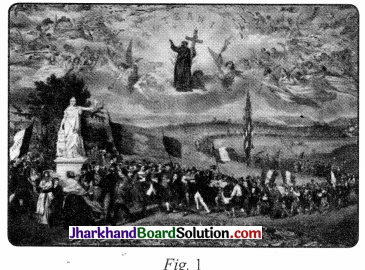
Answer:
‘Utopian Vision’ means that it is depicting something idealistic. The French artist F Sorrieu was visualizing a dream of a world made up of nations (all of them did not exist as nations at the time that these prints were made). He has showed the German people with a common flag, although actually they were a number of different states at that time. So it is an idealistic or Utopian vision.
Page 4
Question 2.
Summarise the attributes of a nation, as Renan understands them. Why, in his view, are nations important?
Answer:
Ernst Renan was a French philosopher who delivered a speech at the University of Sorbonne in 1882. In that speech, he outlined the idea of what makes a nation. According to Renan nations are formed by a common language, race, religion or territory. It is the culmination of a long past of endeavour, sacrifices and devotion. A nation does not take any interest in annexing or holding onto another Nation against its will. Nations are important because their existence guarantee Liberty. The liberty of individuals would be lost if they are no nations.
![]()
Page 8
Question 3.
How7 did nationalism and the idea of the nation-state emerge?
Answer:
Nationalism and the idea of the nation¬state emerged within the culturally and regionally diverse groups of Europe. Due to industrialization and transformation of society there emerged a middle class consisting of businessmen, working professionals, industrialists, labourers and working class people. Out of these, the educated people thought of uniting the culturally compatible sections of people in Europe. This led to nationalism and emergence of the idea of the nation-state.
Page 10
Question 4.
Describe the political ends that List hopes to achieve through economic measures.
Answer:
Professor Friedrich List hopes that economic liberalism and reforms would help in generating national sentiments. These sentiments would be as under:
- Freedom for individual
- Equality of all before law
- Inviolability of private property
- Concept of government by consent
- End of aristocracy and clerical privileges
- A constitution and representative government through parliament.
- The economic reform, according to List would beget liberalism.
Page 11
Question 5.
Plot on a map of Europe the changes drawn up by the Vienna Congress.
Answer:
The Vienna Congress in 1815 changed the boundaries of Europe after the Napoleonic era. The boundaries were changed to make a strong France. Many countries opposed this, but it was remapped with Russia taking most parts of the Napoleonic under its control. The new states with new border were created although Europe with Switzerland being neutral territory. Although Napoleon escaped while in exile but was defeated in Waterloo.
Map of Europe after the changes drawn up by the Vienna Congress.

Question 6.
What is the caricaturist trying to depict?
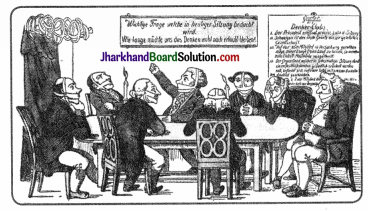
Answer:
The caricaturist is depicting the club of liberal nationalists which dates back 1820.Conservative regimes were set up in 1815. These regimes were autocratic they were not ready to tolerate criticism and dissent. They curbed all the actions which put a question mark on the legitimacy of autocratic governments. Most of the regimes had imposed censorship law to have control over freedom of the press and over songs motivating the ideas of liberty
Page 15
Question 7.
Discuss the importance of language and popular traditions in the creation of national identity.
Answer:
The importance of language and popular traditions in the creation of national identity are as follows:
- The language and popular traditions of a particular region or country give the feeling of shared past, collective and united living to the people.
- They bind all the people by the thread of togetherness and pride.
- They give them the feeling of being culturally one hence they perceive the sentiment of being nationally one and united. Therefore, language and traditions create national identity.
Page 16
Question 8.
Describe the causes of the Silesian weavers’ uprising. Comment on the viewpoint of the journalist.
Answer:
The causes of the Silesian weavers’ uprising were:
- The cause of the Silesian weavers’ uprising was lower payments for finished Textiles.
- Contractors gave raw materials and took away finished textiles from the weavers and paid very less money to the weavers.
- In 1845, weavers of Silesia revolted and this led to the agitation and uprising by weavers against contractors.
- The view point of the journalist that the misery of the workers is extreme and contractors took advantage is totally logical and acceptable.
Question 9.
Imagine you are a weaver who saw1 the events as they unfolded. Write a report on what you saw.
Answer:
I have worked very hard to supply the woven cloth in time, but received very less payment than what was agreed to by the contractor. Since other weavers had also got less payment, on the afternoon of June 4, 1 went along with my partner and other weavers to the contractor’s home for asking for better wages for our weaving. Our demands were scornfully refused and we were even threatened that no more work will be given to us if we did not work at the same rate as what was paid to us.
Some of my fellow weavers got angry at this and broke the window panes of the contractor’s house, barged inside and damaged his furniture and crockery. Some weavers also broke open his store of woven cloth and tore it all up. Seeing this, the contractor ran away from the – house with his family to a nearby village, but there also he did not get shelter. Next day, the contractor returned with soldiers from the army, who fired at our group of weavers, killing eleven of them. I was injured in the leg by a bullet and am now nursing my wounds as 1 write this.
![]()
Question 10.
Compare the positions on the question of women’s rights voiced by the three writers cited above. What do they reveal about liberal ideology?
Answer:
The three writers cited three different views about the women’s rights.
- One of these writers is opposed any political right to women.
- The second writer is criticizing the men who try to gain freedom and liberty only for men. At the same time, the second writer advocates that women should be given political rights.
- The third writer is in favour of women’s rights. He cited a comparative study between position of men and women and is in favour of women rights.
- First, second, and third writers wrote about big divisions in the liberal ideology.
- The liberal thinkers and writers, were divided on the question of the women’s rights.
Page 20
Question 11.
Describe the caricature. How does it represent the relationship between Bismarck and the elected deputies of Parliament? What interpretation of democratic processes is the artist trying to convey?
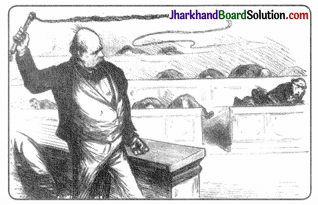
Answer:
The caricature depicts Bismarck, Chancellor of Germany as holding a whip (signifying that he is a ruthless man ruling with an iron hand) while leading the Parliament. The deputies who were elected are afraid of him and so are hiding under their tables. The caricature depicts the dominance of Bismarck over the deputies and how he despised liberalism and parliamentary assemblies. The artist is trying to convey that the democratic process in Germany was very shallow and the roots of constitutionalism were poor.
Question 12.
Look at Fig. 14(a). Do you think that the people living in any of these regions thought of themselves as Italians? Examine Fig. 14(b). Which was the first region to become a part of unified Italy? Which was the last region to join? In which year did the largest number of states join?
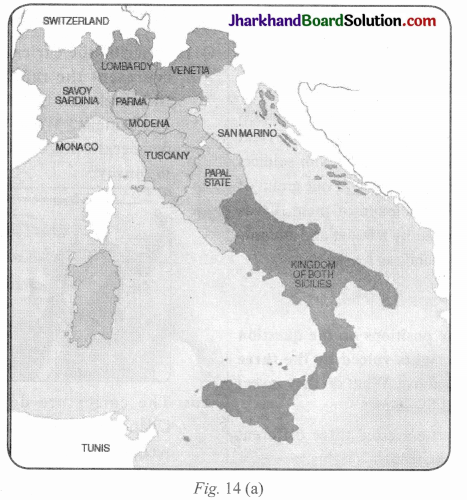
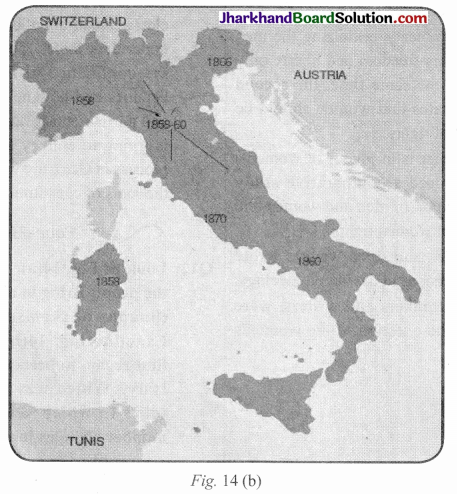
Answer:
In 1858, Italy was divided into seven states, with the North being under the Austrian Habsburgs, the centre being ruled by the Pope and the Southern regions being under Spain’s domination. Only one state, Sardinia-Piedmont was ruled by an Italian princely house. The Italian language also had not acquired a common form and had many regional and local variations. So people living in these regions, except Sardinia -Piedmont, would not have thought of themselves as Italians. The first regions to become a part of unified Italy in 1858 were Savoy Sardinia followed by the Northern states. The last region to join was the Papal State in 1870. The largest number of states joined in 1860.
![]()
Page 22
Question 13.
The artist has portrayed Garibaldi as holding on to the base of the boot, so that the King of Sardinia-Piedmont can enter it from the top. Look at the map of Italy once more. What statement is this caricature making?
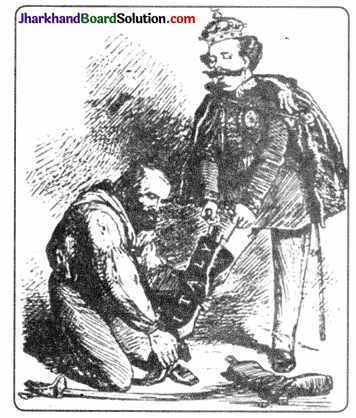
Answer:
The base of the boot symbolizes the Kingdom of the Two Sicilians, which lay in the southernmost part of the Italian peninsula. Garibaldi had won this kingdom and handed it over to King Victor Emmanuel II. This cartoon signifies the unification of Italy and Garibaldi’s role in it.
Page 24
Question 14.
With the help of the chart in Box 3, identify the attributes of Veit’s Germania and interpret the symbolic meaning of the painting. In an earlier allegorical rendering of 1836, Veit had portrayed the Kaiser’s crown at the place where he has now located the broken chain. Explain the significance of this change. Box 3
| Attribute | Significance |
| Broken chains | Being freed |
| Breastplate with eagle | Symbol of the German empire – strength |
| Crown of oak leaves | Heroism |
| Sword | Readiness to fight |
| Olive branch around the sword | Willingness to make peace |
| Black, red and gold tricolour | Flag of the liberal- nationalists in 1848, banned by the Dukes of the German states |
| Rays of the rising sun | Beginning of a new era |
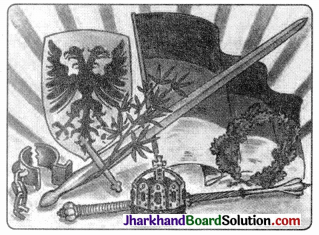
Answer:
The symbolic meaning of the painting is that the German nation has emerged. The female figure of Germania is an allegory of the German nation. All the attributes of the German nation can be “seen in the painting as given in Box 3. The replacement of the Kaiser’s crown with the broken chain signifies that the German nation is now free from autocratic monarchical rule.
Question 15.
Describe what you see in Fig. 18. What historical events could Hiibner be referring to in this allegorical vision of the nation?
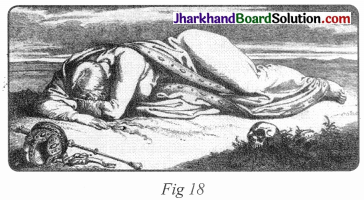
Answer:
The painter depicted Germania as a fallen woman with the crown and standard thrown aside because German people’s hopes to be united under one monarch (King Friedrich Willhelm IV) were dashed as he rejected their demand in 1848. The artist, Julius Hubner, depicted Germania in a forlorn state due to this rejection by the king. It symbolized the loss of hope. The crown and standard are symbols of the monarchy, which have been cast aside.
Page 25
Question 16.
Look once more at Fig. 10. Imagine you were a citizen of Frankfurt in March 1848 and were present during the proceedings of the Parliament. How would you (a) as a man seated in the hall of deputies, and (b) as a woman observing from the galleries, relate to the banner of Germania hanging from the ceiling?
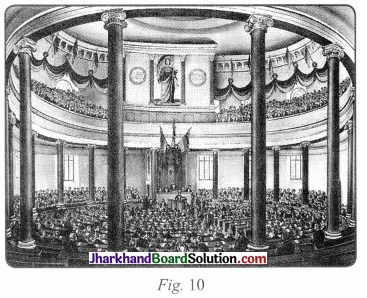
Answer:
(a) As a man seated in the hall of deputies, I would relate positively to the banner of Germania, as I would feel all that it symbolized was coming true.
(b) As a woman observing from the galleries, I would consider the banner to depict the truth only partially Women had participated with men equally in the struggle for constitutionalism with national unification, but they were denied suffrage rights during elections to the National Assembly, Women were only admitted to the assembly as passive citizens and observers.
JAC Class 10th History The Rise of Nationalism in Europe Textbook Questions and Answers
Question 1.
Write a note on:
(a) Guiseppe Mazzini
(b) Count Camillo de Cavour
(c) The Greek war of independence
(d) Frankfurt parliament
(e) The role of women in nationalist struggles
Answer:
(a) Giuseppe Mazzini: Giuseppe Mazzini was an ItaliWan revolutionary born in Genoa in 1807, he became a member of the Secret Society of the Carbonari. As a young man of 24, he was sent into exile in 1831 for attempting a revolution in Liguria. He subsequently founded two more underground societies, first, Young Italy in Marseilles, and then, Young Europe in Berne, whose members were like-minded young men from Poland, France, Italy and the German ‘ states.
Mazzini believed that God had intended nations to be the natural units of mankind. So Italy could not continue to be a patchwork of small states and kingdoms. It had to be forged into a single unified republic within a wider alliance of nations. This unification alone could be the basis of Italian liberty.
(b) Count Camillo de Cavour led the movement to unify the regions of Italy was neither a revolutionary nor a democrat. Like many other wealthy and educated members of the Italian elite, he spoke French much better than he did Italian. Through a tactful diplomatic alliance with France engineered by Cavour, Sardinia-Piedmont succeeded in defeating the Austrian forces in 1859.
(c) The Greek war of independence: An event that mobilised nationalist feelings among the educated elite across Europe was the Greek war of independence. Greece had been part of the,Ottoman Empire since the fifteenth century. The growth of revolutionary nationalism in Europe sparked off a struggle for independence amongst the Greeks which began in 1821. Nationalists in Greece got support from other Greeks living in exile -and also from many West Europeans who had sympathies for ancient Greek culture. Finally, the Treaty of Constantinople of 1832 recognised Greece as an independent nation. ,
(d) FranKfurt parliament: The German middle class decided to vote for an all German National Assembly in 1848, and hence came to Frankfurt. Around 831 persons were elected. They comprised the’National Assembly. The assembly decided to organize Frankfurt parliament in the church of St. Paul. Thus on 18 May, 1848 the famous Frankfurt parliament was convened. The assembly decided that the German nation would be a monarchy controlled by parliament, and offered this term to the Prussian king, the latter rejected the terms and proposal of the assembly.
Also the middle classes were restored to the suppression of working class and artisans. This led to the division among the liberal-minded persons. The parliament got disrupted and people came to blows. In order to control the situation, military was called in the assembly hall. Thus, the monarchy and military combined together with autocracy won over the liberal nationalist middle class. The Frankfurt parliament is famous in history as failure of liberalism and victory of monarchy.
(e) The role of women in nationalist struggles: Women played a very significant role in the nationalist struggles all over the world. They led the movements, bore the blows of police and military men, stood by their male counterparts; spread the ideas of liberal nationalism in the urban and countryside areas of Europe. But women were dissatisfied a lot. They, inspite of their very active participation in nationalist struggles, did not get their share of cake, i.e., they could not secure the right to vote, or the political rights for themselves till the end of 19th century.
![]()
Question 2.
What steps did the French revolutionaries take to create a sense of collective identity among the French people?
Answer:
The French revolutionaries took follow¬ing steps to create a sense of collective identify among the French people:
- They introduced the ideas of la patrie (the fatherland) and le citoyen (the citizens).
- These ideas emphasized the notion of a united community enjoying equal rights under a constitution.
- Anew French flag, the tricolour, to replace the former royal standard was chosen.
- They elected the Estates-General by active citizens and it was renamed as National Assembly.
- They composed new hymns, took oaths and commemorated martyrs, all in the name of nation.
- They established a centralized administrative system, which formulated uniform laws for all citizens.
- They adopted a uniform system of weights and measures and abolished internal customs duties and dues.
- They promoted French over the regional dialects.
- They also declared that it was the mission and destiny of the French nation to liberate the people of Europe from despotism, i.e., to help other people of Europe to become nations.
Question 3.
Who were Marianne and Germania? What was the importance of the way in which they were portrayed?
Answer:
- Marianne was the allegory or symbol of French nation.
- Germania was the allegory or symbol of German nation.
- They were portrayed in a way to reflect the idea of nation-state.
- They represented their respective country as if it w^ere a person. It sought to give an abstract idea of the nation in a concrete form.
Question 4.
Briefly trace the process of German unification.
Answer:
- The liberal minded middle class of German confederacy met in the Frankfurt parliament in 1848, with an objective of establishing Germany as a nation. But they failed miserably.
- The parliament ended with monarchical, military and aristocratic triumph.
- Later on, the chief minister of Prussia, Otto von Bismark, architect of this process, led the movement of unity of the German confederacy.
- He organised this process with the help of Prussian army and bureaucracy.
- They fought three wars for over seven years with Austria, Denmark and France, which ended in Prussian victory. This completed the process of German unification.
- In January 1871, the Prussian king, William I was proclaimed German emperor in a ceremony held at Versailles.
Question 5.
What changes did Napoleon introduce to make the administrative system more efficient in the territories ruled by him?
Answer:
Napoleon introduced following administrative reforms in the areas ruled by him:
- He made administrative system more rational and effective.
- The Civil Code of 1804 or Napoleonic code did away with all privileges based on birth, established equality before law and secured the right to property.
- He simplified administrative system, ended feudal system, and freed peasants from serfdom and monarchical dues.
- In towns too, guild system were removed. Transport and communication systems were improved.
- Peasants, artisans, businessmen and workers enjoyed the new found freedom.
NCERT ‘Discuss’ Questions
Question 1.
Explain what is meant by the 1848 revolution of the liberals. What were the political, social and economic ideas supported by the liberals?
countries at that time, but leading to the unification of both countries eventually.
Answer:
The 1848 revolution of the liberals refers to the revolution led by the educated middle classes of Europe. Events of February 1848, in France brought about the abdication of the monarchy and a republic based on universal male franchise was formed.
- Politically, they demanded constitutionalism with national unification a nation-state with a written constitution and parliamentary administration.
- Socially, they wanted to rid society of its class-based partialities and birth rights. Serfdom and bonded labour had to be abolished.
- Economically all they wanted freedom of markets and right to property.
Question 2.
Choose three examples to show the contribution of culture to the growth of nationalism in Europe.
Answer:
Three examples to show the contribution of culture to the growth of nationalism in Europe were:
(i) Romanticism was a European cultural movement aimed at developing national unity by creating a sense of shared heritage and common history. The Romantic artists’ emphasised on emotions, intuition and mystical feelings gave shape and expression to nationalist sentiments. The strength of art in promoting nationalism is well exemplified in the role played by European poets and artists in mobilising -public’opinion to support the Greeks in their struggle to establish their national identity.
(ii) Folk songs, dances and poetry popularised the spirit of nationalism and patriotic fervour in Europe. Collecting and recording the different forms of folk culture was important for building a national consciousness. Being a part of the lives of the common people, folk culture enabled nationalists to carry the message of nationalism to a large and diverse audience. The Polish composer Karol Kurpinski celebrated and popularised the Polish nationalist struggle through his operas and music, turning folk dances like the polonaise and mazurka into nationalist symbols.
(iii) Language played a distinctive role in developing nationalist feelings in Europe. An example of this is how during Russian occupation, the use of Polish came to be seen as a symbol of struggle against Russian dominance. During this period, Polish language was forced out of schools and Russian language was imposed everywhere.
Following the defeat of an armed rebellion against Russian rule in 1831, many members of the clergy in Poland began using language as a weapon of national resistance. They did so by refusing to preach in Russian, and by using Polish for Church gatherings and religious instruction. The emphasis on the use of vernacular language, the language of the masses, helped spread the message of national unity.
![]()
Question 3.
Through a focus on any two countries, explain how nations developed over the nineteenth century.
Answer:
Italy and Germany were two important European countries that developed during the nineteenth century. Both these countries were previously ruled by several princely states and were divided into many smaller independent segments, till the middle of 19th century.
- As there were some mass revolutions in various parts of Europe in 19th century and people became more educated, the common people of all these states unified to form common governments.
- In Germany, German National Assembly was formed in 1848 and in Italy, the revolutionists tried to form unified Italian Republic; though they failed in both
Question 4.
How was the history of nationalism in Britain unlike the rest of Europe?
Answer:
(i) In Britain, the formation of the nation-state was not the result of a sudden upheaval or revolution. It was the result of a long-drawn-out process.
(ii) There was no British nation prior to the eighteenth century. The primary identities of the people who inhabited the British Isles were ethnic – such as English, Welsh, Scot or Irish. All these ethnic groups had their own cultural and political traditions.
(iii) But as the English nation steadily grew in wealth, importance and power, it was able to extend its influence over the other nations of the islands.
(iv) The English parliament, seized power from the monarchy in 1688 at the end of a conflict, was an instrument through which a nation-state, with England at its centre, came to be forged.
(v) The Act ofUnion (1707) between England and Scotland that resulted in the formation of the ‘United Kingdom of Great Britain’ meant, that England was able to impose its influence on Scotland. The.British parliament was dominated by its English members.
(vi) The growth of a British identity meant that Scotland’s distinctive culture and political institutions were suppressed. The Catholic clans that inhabited the Scottish Highlands suffered terrible repression whenever they attempted to assert their independence. The Scottish Highlanders were forbidden to speak their Gaelic language or wear their national dress, and large numbers were forcibly driven out of their homeland.
![]()
Question 5.
Why did nationalist tensions emerge in the Balkans?
Answer:
(i) The most serious source of nationalist tension in Europe after 1871 was the area called the Balkans. The Balkans was a region of geographical and ethnic variation comprising modern-day Romania, Bulgaria, Albania, Greece, Macedonia, Croatia, Bosnia-Herzegovina, Slovenia, Serbia and Montenegro whose inhabitants were broadly known as the Slavs.
(ii) A large part of the Balkans was under the control of the Ottoman Empire. The spread of the ideas of romantic nationalism with disintegration of the Ottoman Empire made this region very explosive.
(iii) All through the nineteenth century the Ottoman Empire had sought to strengthen itself through modernisation and internal reforms but with very little success. One by one, its European subject nationalities broke away from its control and declared independence.
(iv) The Balkan people based their claims for independence or political rights on nationality and used history to prove that they had once been independent but had subsequently been subjugated by foreign powers.
(v) The rebellious nationalities in the Balkans thought of their struggles as attempts to win back their long-lost independence.